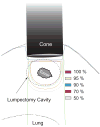Cosmetic outcomes for accelerated partial breast irradiation before surgical excision of early-stage breast cancer using single-dose intraoperative radiotherapy
- PMID: 20395062
- PMCID: PMC2941525
- DOI: 10.1016/j.ijrobp.2009.10.032
Cosmetic outcomes for accelerated partial breast irradiation before surgical excision of early-stage breast cancer using single-dose intraoperative radiotherapy
Abstract
Purpose: Determine cosmetic outcome and toxicity profile of intraoperative radiation delivered before tumor excision for patients with early-stage breast cancer.
Methods and materials: Patients age 48 or older with ultrasound-visible invasive ductal cancers <3 cm and clinically negative lymph nodes were eligible for treatment on this institutional review board-approved Phase II clinical trial. Treatment planning ultrasound was used to select an electron energy and cone size sufficient to cover the tumor plus a 1.5- to 2.0-cm circumferential margin laterally and a 1-cm-deep margin with the 90% isodose line. The dose was prescribed to a nominal 15 Gy and delivered using a Mobetron electron irradiator before tumor excision by segmental mastectomy. Physician- and patient-assessed cosmetic outcome and patient satisfaction were determined by questionnaire.
Results: From March 2003 to July 2007, 71 patients were treated with intraoperative radiation therapy. Of those, 56 patients were evaluable, with a median follow-up of 3.1 years (minimum 1 year). Physician and patient assessment of cosmesis was "good or excellent" (Radiation Therapy Oncology Group cosmesis scale) in 45/56 (80%) and 32/42 (76%) of all patients, respectively. Eleven patients who received additional whole breast radiation had similar rates of good or excellent cosmesis: 40/48 (83%) and 29/36 (81%), respectively). Grade 1 or 2 acute toxicities were seen in 4/71 (6%) patients. No Grade 3 or 4 toxicities or serious adverse events have been seen.
Conclusion: Intraoperative radiotherapy delivered to an in situ tumor is feasible with acceptable acute tolerance. Patient and physician assessment of the cosmetic outcome is good to excellent.
Copyright © 2011 Elsevier Inc. All rights reserved.
Conflict of interest statement
Conflicts of Interest: The authors report no potential conflicts of interest related to this manuscript.
Figures




Similar articles
-
Phase 2 study of pre-excision single-dose intraoperative radiation therapy for early-stage breast cancers: six-year update with application of the ASTRO accelerated partial breast irradiation consensus statement criteria.Cancer. 2013 May 1;119(9):1736-43. doi: 10.1002/cncr.27915. Epub 2013 Jan 29. Cancer. 2013. PMID: 23361892 Free PMC article. Clinical Trial.
-
Late side-effects and cosmetic results of accelerated partial breast irradiation with interstitial brachytherapy versus whole-breast irradiation after breast-conserving surgery for low-risk invasive and in-situ carcinoma of the female breast: 5-year results of a randomised, controlled, phase 3 trial.Lancet Oncol. 2017 Feb;18(2):259-268. doi: 10.1016/S1470-2045(17)30011-6. Epub 2017 Jan 14. Lancet Oncol. 2017. PMID: 28094198 Clinical Trial.
-
Preliminary Results of a Phase 1 Dose-Escalation Trial for Early-Stage Breast Cancer Using 5-Fraction Stereotactic Body Radiation Therapy for Partial-Breast Irradiation.Int J Radiat Oncol Biol Phys. 2017 May 1;98(1):196-205.e2. doi: 10.1016/j.ijrobp.2017.01.020. Epub 2017 Jan 12. Int J Radiat Oncol Biol Phys. 2017. PMID: 28586960 Clinical Trial.
-
Decline of cosmetic outcomes following accelerated partial breast irradiation using intensity modulated radiation therapy: results of a single-institution prospective clinical trial.Int J Radiat Oncol Biol Phys. 2014 May 1;89(1):96-102. doi: 10.1016/j.ijrobp.2014.01.005. Epub 2014 Mar 7. Int J Radiat Oncol Biol Phys. 2014. PMID: 24613813 Free PMC article.
-
Accelerated partial breast irradiation using only intraoperative electron radiation therapy in early stage breast cancer.Int J Radiat Oncol Biol Phys. 2012 Oct 1;84(2):e145-52. doi: 10.1016/j.ijrobp.2012.03.013. Epub 2012 Apr 28. Int J Radiat Oncol Biol Phys. 2012. PMID: 22543201 Clinical Trial.
Cited by
-
Intraoperative radiotherapy in early stage breast cancer: potential indications and evidence to date.Br J Radiol. 2015 May;88(1049):20140686. doi: 10.1259/bjr.20140686. Epub 2015 Mar 3. Br J Radiol. 2015. PMID: 25734489 Free PMC article. Review.
-
Phase 2 study of pre-excision single-dose intraoperative radiation therapy for early-stage breast cancers: six-year update with application of the ASTRO accelerated partial breast irradiation consensus statement criteria.Cancer. 2013 May 1;119(9):1736-43. doi: 10.1002/cncr.27915. Epub 2013 Jan 29. Cancer. 2013. PMID: 23361892 Free PMC article. Clinical Trial.
-
Cosmetic changes following surgery and accelerated partial breast irradiation using HDR interstitial brachytherapy : Evaluation by a multidisciplinary/multigender committee.Strahlenther Onkol. 2017 May;193(5):367-374. doi: 10.1007/s00066-016-1093-6. Epub 2017 Jan 2. Strahlenther Onkol. 2017. PMID: 28044202 English.
-
Preoperative Partial Breast Irradiation in Patients with Low-Risk Breast Cancer: A Systematic Review of Literature.Ann Surg Oncol. 2023 Jun;30(6):3263-3279. doi: 10.1245/s10434-023-13233-9. Epub 2023 Mar 3. Ann Surg Oncol. 2023. PMID: 36869253 Free PMC article.
-
Intraoperative radiation therapy delivered prior to lumpectomy for early-stage breast cancer: a single institution study.Am J Cancer Res. 2015 Jun 15;5(7):2249-57. eCollection 2015. Am J Cancer Res. 2015. PMID: 26328255 Free PMC article.
References
-
- Morrow M, White J, Moughan J, et al. Factors predicting the use of breast-conserving therapy in stage I and II breast carcinoma. J Clin Oncol. 2001;19:2254–2262. - PubMed
-
- Nattinger AB, Hoffmann RG, Kneusel RT, et al. Relation between appropriateness of primary therapy for early-stage breast carcinoma and increased use of breast-conserving surgery. Lancet. 2000;356:1148–1153. - PubMed
-
- McGinnis LS, Menck HR, Eyre HJ, et al. National Cancer Data Base survey of breast cancer management for patients from low income zip codes. Cancer. 2000;88:933–945. - PubMed
-
- Mandelblatt JS, Hadley J, Kerner JF, et al. Patterns of breast carcinoma treatment in older women: patient preference and clinical and physical influences. Cancer. 2000;89:561–573. - PubMed
-
- Nattinger AB, Kneusel RT, Hoffmann RG, et al. Relationship of distance from a radiotherapy facility and initial breast cancer treatment. J Natl Cancer Inst. 2001;93:1344–1346. - PubMed
Publication types
MeSH terms
Grants and funding
LinkOut - more resources
Full Text Sources
Other Literature Sources
Medical

